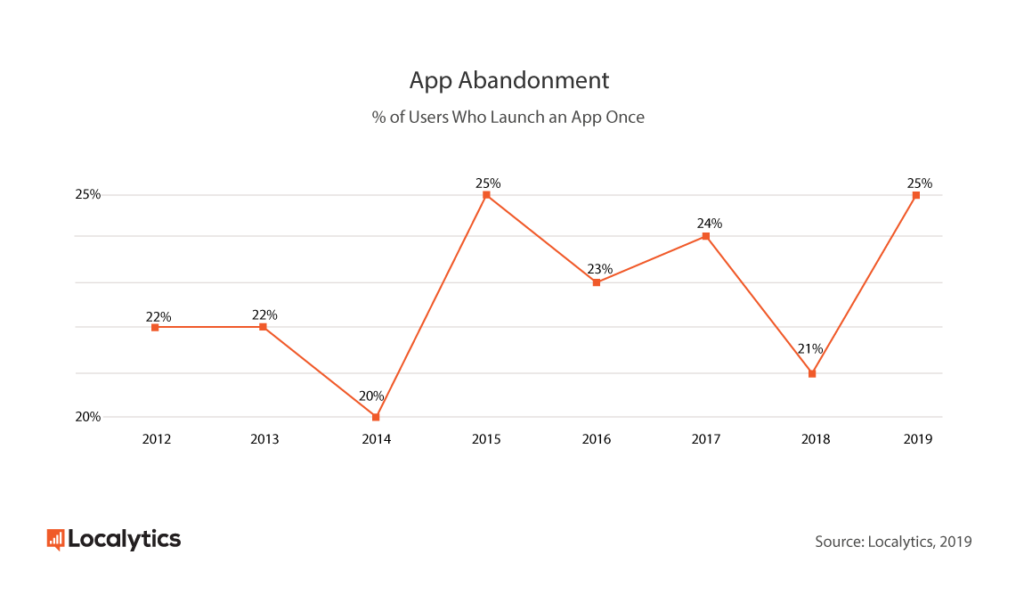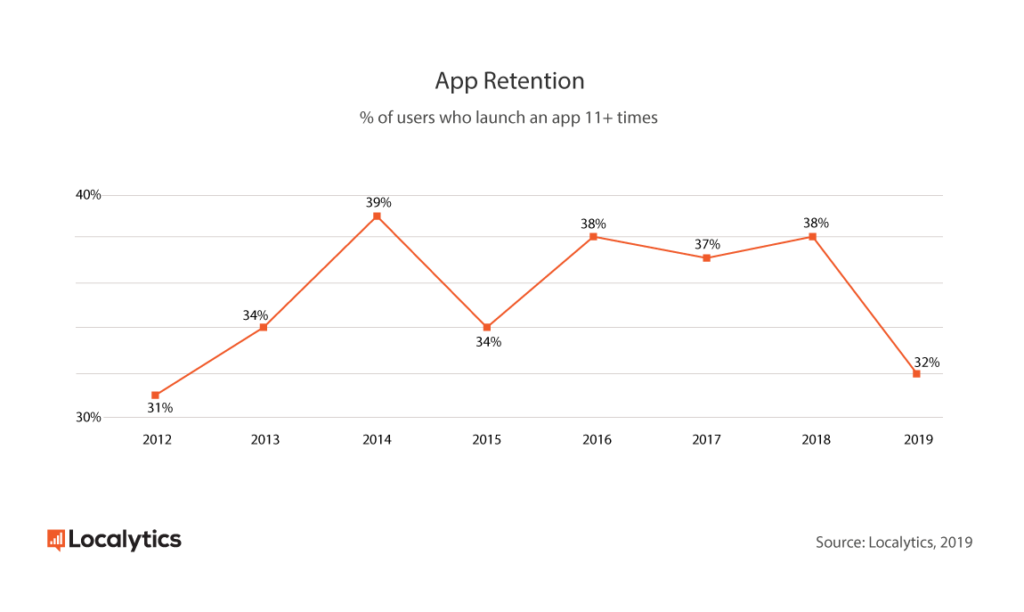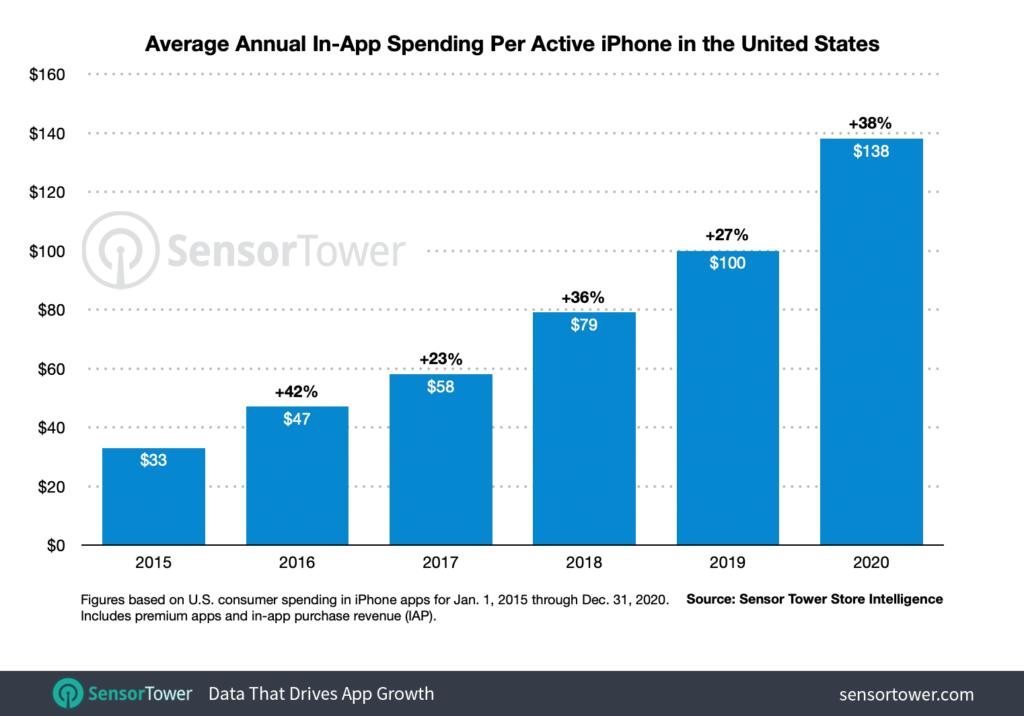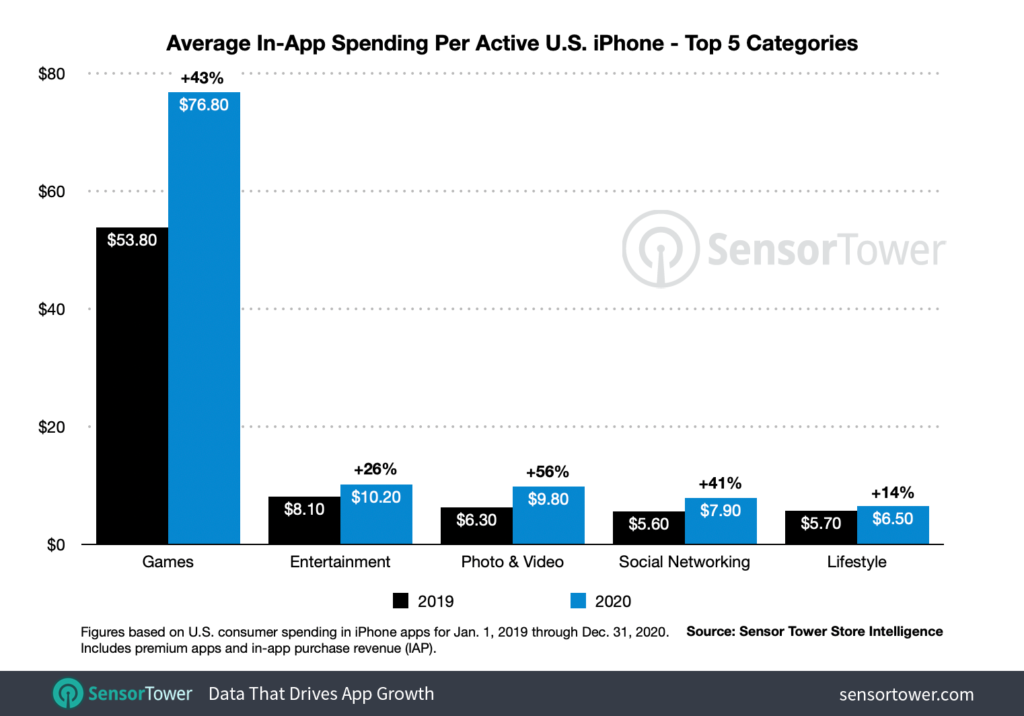
The majority of people globally have access to a smartphone. And they spend an increasing amount of time and money on apps.
This means there is a huge opportunity for developers to get their products in front of a vast audience.
But to create a successful app, you need a good understanding of the app industry and how people download and interact with these tools.
This knowledge will drive your app development and marketing strategy. It will guide you on the most important monetization methods, app usage benchmarks, and the type of apps you should create if you want to become successful.
With that in mind, here is a selection of over 40 of the most enlightening mobile app statistics from across the web.
Table of Contents
Top 10 Mobile App Statistics
Here are ten of the most insightful mobile app statistics.
- The Google Play Store is the biggest app marketplace in terms of the number of apps available. It has 3.1 million apps that users can download.
- The Apple App Store has the second-largest selection, with 2.1 million apps available.
- Studies suggest that people spend around 4.2 hours a day using apps. And they have approximately 80 apps installed on their devices.
- But 25% of app users launch an app just once. User retention is a significant problem.
- Games are by far the most popular type of app. This is followed by education on Google Play Store and business on the Apple App Store.
- 58% of app installs come from people searching on app marketplaces. Other ways people access apps include referrals and browsing the stores.
- Consumer spending on Google Play Store and the Apple App Store almost hit an astonishing $30 billion in the third quarter of 2020.
- There’s good news if you want to sell your app: they are getting more expensive. The median price for (non-gaming) in-app purchases was $5.99 in 2020.
- But only 3% of Android app developers actually charge for their apps.
- Perhaps the above statistic is because advertisers spent $240 billion on mobile ads in 2020.
App Store Statistics: How Do the Main App Stores Compare?
To release a successful app, you need to make it readily available to your users. That means releasing it on mobile app marketplaces.
Outside China, there are two major app marketplaces: the Google Play Store for Android devices and the Apple App Store for iOS devices. Almost all successful apps are available on one or both of these platforms.
Apple App Store vs. Google Play Store
Android users have a far bigger selection of apps to choose from than iOS users.
In the fourth quarter of 2020, there were 3.1 million apps available to download on the Google Play Store. This compares to a selection of 2.1 million apps in the Apple App Store.
While the Apple App Store has 1 million fewer apps, both stores have more than enough to keep users happy. And many of the most popular apps are available on both platforms.
The size of the respective mobile app stores reflects the global dominance of Google’s platform. Estimates suggest that 72% of phones worldwide operated on Android in March 2021.
However,iOS is more prevalent in countries such as the U.S. and Japan. In the U.S, 60% of smartphone owners used Apple products.
Other App Store Options
There are other app stores available, albeit operating on a smaller scale.
For example, the Amazon Appstore caters mainly to Kindle devices and offers around 450,000 apps. Still not a bad selection!
Then there’s the Samsung Galaxy Store which provides apps for Samsung phones, including many of the company’s native apps.
Android users are able to download app APKs, transfer them to their phones, and install them directly.
This means if you want to build an app, you can do so without releasing it on the Google Play Store. Doing so helps you avoid the large app commission fees the platform charges.
This is a strategy most famously used by Epic Games when it released the Android version of mega-hit Fortnite. Instead of letting users download the app on Google Play, it pointed them to a page on its website where they could download the game directly.
As we’ll discover later in the article, most app downloads come through app marketplaces. It’s hard to get your app in front of an audience if you aren’t on these platforms.
Unless you have the brand power of Fortnite or access to a direct audience, you’ll be better off using official channels.
What about China?
If you want to make your mobile app available to users in China, be aware that the app-store market is far more fractured.
The biggest store is run by Tencent. Many of the major phone manufacturers like Huawei, Oppo, Xiaomi, and VIVO all publish apps on their own stores. The Apple App Store is available for iPhone users.
Mobile App Usage Statistics: How Do People Use Apps?
Why are there so many apps? Probably because so many people have access to them. You won’t be surprised to hear that85% of Americans own a smartphone and 53% own a tablet.

Globally, around 80% of people have access to a smartphone. And smartphones are the main way that people in many countries around the world access the internet.
If you own a smartphone, you know how tempting it can be to spend time using it. And you’ll also know that most of this time is spent using apps. Many of these apps are ones you will have downloaded from the major marketplaces.
Recently there has been an increase in awareness around digital wellbeing. Both iOS and Android phones have usage calculators that tell users how much time they are spending in-app.
Despite this, mobile app usage appears to be growing.
In the first quarter of 2021, people spent an average of 4.2 hours a day using apps. This was a 30% increase compared to just two years prior. In Indonesia, South Korea, and Brazil, the total time spent using apps was over five hours. In the U.S, the figure was just over four hours.
People spread this time over multiple sessions. While each session is short, they add up throughout the day.
A 2018 study aimed to find how much time users spent on their phones when they didn’t have work commitments. It found that while on vacation, the average American checked their phone 80 times per day. This works out at five times an hour or once every 12 minutes.
And this was just the average person. Power users reported checking their phones over 300 times.
People spread this time across various apps. The average smartphone user globally has 80 apps installed on their device.
But there is a considerable disparity between the number of apps people have and the number they use. The same survey found that of the 80 apps people have installed, they only use around 40 each month.
Retaining App Users Is Tough
Keeping users engaged is a significant challenge for app developers. Smartphone owners are happy to download apps to try them out, but they often stop using them soon after. This is a problem if your app relies on repeat uses to generate revenue.
Reports estimate that 25% of users launch an app just once after downloading it. Considering the average session with an app is 5 minutes and 26 seconds, you don’t have long to make an impact.

This retention rate continues to drop off with more uses. Only 32% of people launch an app more than ten times after downloading it.

Other reports support these findings. For example, this one suggests that 72.76% of users churn after just three months.
The question is, how can you keep people using your app?
A good onboarding experience will help encourage users to see the value in your app quickly, while in-app notifications are a good way to bring people back to your product.
Some developers benefit from promoting their app on Facebook to encourage people to return to it. Ecommerce stores are likely to find this strategy especially useful.
App Download Statistics: What Types of Apps Are Most Popular?
While there are many apps available, some types of apps are more popular than others. This section will look at the most popular app categories.
Mobile Gaming Is Huge
Games are by far the most popular category on both the App Store and Google Play, based on total apps available and number of apps downloaded.
During 2020, the impact of COVID-19 meant that 1.75 billion people played smartphone games in March, up from 1.2 billion in January.
In the same year, the total estimated time spent in games by all users in the last ten days of March was over 90 million hours. Game Analytics attributed this to both the increase in people playing and the impact of people playing for longer.
While gaming apps are number one, the rest of the top five most popular app categories are different on iOS and Android.
There are 283,000 education apps on Google Play, making it the most popular type of non-game app on the marketplace based on the number of mobile apps available. This is followed by the categories of business, music, audio, tools, then entertainment.
The App Store, on the other hand, has more business apps than any other non-game category. This category makes up 10.11% of the total. Education, lifestyle, utilities, and entertainment apps make up the top five.
Things are slightly different if you look at the number of app downloads in each app category.
On the Google Play Store, the top five app categories for this metric in Q4 2020 were gaming apps, tools, entertainment, social, and video players.
In the same quarter, the top five categories on the Apple App Store were games, photo and video, utilities, shopping, and entertainment.
The most downloaded mobile apps change depending on trends at the time.
In 2020, nine of the top ten apps with the most downloads worldwide were communication or social media apps. Netflix was the only one that wasn’t in this category.
Most Downloaded Mobile Apps in 2020 🏆 |
|
App Marketing Statistics: How Do People Find Apps?There are over sixty apps that have more than a billion app downloads on the Google Play Store. Many of these are included natively on the operating system, such as the Google Suite of apps.
With so many apps available, getting people to download your app is a significant challenge. App marketing can help as long as you know the most effective channels to use.
Most developers won’t be surprised to hear that58% of all app installs come from people searching on the relevant app marketplace. This channel is even more important for non-game mobile apps, where 70% of downloads come from searches.

To ensure your app gets found, you must optimize your app marketplace profile for search visibility and conversion. This will increase the chances of people both finding your app and downloading it.
Our guide to app marketing strategies has further details about how to boost your profile.
The next most important channel is app referrals, which led to 20% of total installs in 2020. This channel was the most important one for gaming apps: 38% of game app downloads were due to referrals, compared to just 35% from searches.
If you build an app, encourage downloads by making it as easy as possible for users to share your app with people they know. Consider offering incentives to people who share your app or build in social features that improve the user experience as more people sign up.
Beyond these two main channels, 12% of app downloads came from people browsing the app store, 8% were from web referrals, and the remainder came from unknown sources.
App Monetization Statistics: How to Make Money with an App
Creating a successful app can be immensely lucrative.
Spending on the two leading app stores hit almost$30 billion in the third quarter of 2020, with the App Store accounting for $19 billion of this and Google Play making up $10.3 billion. This statistic is especially notable considering the smaller size of the Apple App Store.
This spending is predicted to not only continue but to increase in size. Statista says that app spending will more than double by 2025 globally. The App Store is expected to take in $185 billion and Google Play is predicted to generate $85 billion.

Apps and games are usually monetized via either one-off purchases, subscriptions, in-app purchases, or ads. You can be successful with each of these strategies. The key is to find the one that fits your app.
Games are incredibly lucrative.
Honor of Kings/Arena of Valor is the highest-earning app. It has brought in almost $10 billion since its release in 2015. At the time of writing, 33 different games have hit the $1 billion revenue target.
It often doesn’t take long for games to reach this figure. Genshin Impact recently brought in $1 billion in under six months, surpassing Pokemon Go to become the fastest app to reach this target.
The latter game brought in around $5.70 per download, despite being free to play.
In-App Spending Is Increasing
These numbers show app users are spending big. In the U.S., iPhone users spent an average of $138 on Apple App Store apps in 2020—a 38% increase on 2019.

Games account for $76.80, or more than half of this average spend. The next most lucrative categories were entertainment ($10.20 of the total), photo and video ($9.80), social networking ($7.90), and then lifestyle ($6.50).

As people get more used to spending on apps, their average cost is rising.
The median price of in-app purchases in non-gaming apps on iOS hit $5.99 in 2020. This was 150% more than the median price of an iOS app in 2017.
Additionally, while most non-game apps (65.3%) still cost between $0.49 and $9.99, the percentage of more expensive apps is growing. 26.5% of iOS apps now cost between $10 and $49.99, an 8% increase on 2017. The percentage of apps costing over $50 also increased.
Subscription pricing models have been growing in importance over the past few years.
This is now the dominant form of pricing for non-game apps, with 53% of apps being monetized via recurring payments. This was a huge increase since two years ago, when only 35% of apps were monetized in this way.
Both App Stores Take Big Commissions
When monetizing your app, be aware that both platforms take a hefty amount as a commission—although recent changes have seen this percentage decrease in some cases.
Apple takes 30% of revenue generated through app sales and in-app purchases. In December 2020, the company cut this percentage to just 15% for businesses with yearly app-store revenues of up to $1 million. This was good news for small publishers in the app industry.
Google’s pricing structure is similar. The search giant takes 30% of revenue made via downloads of Android apps. In July 2021, the company will switch to a model that will see it take 15% of an app’s revenue for the first $1 million a developer makes.
The major difference between the two pricing policies is that on Google Play, the 15% commission on the first $1 million applies to all developers no matter how much they make in total. Apple’s commission cut only applies to those that make under $1 million in total.
Free vs. Paid Apps
While the above changes are good news for publishers in the app industry, they may not affect as many publishers as you might think. Only 3% of Android app developers charge for their apps.
This doesn’t mean these people aren’t making money, however. You can monetize free apps with ads, which can be incredibly lucrative. Advertisers spent $240 billion on mobile ads in 2020.
Mobile App Statistics: In Conclusion
So there you have it: over 40 statistics about how people use, download and spend on apps. If you’re creating an app, use them to guide your strategy to success.
The key factors to remember are that there are opportunities for both paid apps and monetization via ads, and that retention is a key challenge. If you really want to hit the big time, creating a mobile game might be the way to go.

0 thoughts on “40+ Enlightening Mobile App and App Store Statistics”